I joined the business in 1985.
The best agency seemed to be Bartle Bogle Hegarty.
Every year ever since they’ve been in the top five,
sometimes they’ve been in the top one.
Their success has been very well documented,
what did Sir John did before that hasn’t been.
So…
Where were you brought up?
I was born in North London, although at that point Edgware wasn’t in London, it was in Middlesex, which doesn’t exist anymore.
My family was living in Collindale, but as the War was on, we were constantly being bombed out, so I lived in Golders Green, Finchley and Mill Hill.
But throughout my life I’ve gradually moved closer and closer to the centre.
I’ve never understood why people move out to the countryside as they get older; no stimulation, no people, you’ve now got all the time in the world and now have nothing to do?
I used to say my view of the countryside is that it’s full of farmers and fascists, or farmers and fox hunters, when I’m in polite company.
What was the first ad you remember seeing?
The very first ad I was aware of was for Guinness, I was about 8 years old, it was a poster, and I went back to my father and said ‘I’ve just seen a poster I don’t really understand it said “Down With Guinness”?’
He said ‘Ah, now that’s a little joke, it means drink it down, not down with Guinness’
I thought that’s quite clever.
Interesting it was a poster, I think it’s wonderful that Today posters are probably going to be one of the most powerful mediums with the change of technology and posters changing by the hour, you’ll see one for coffee driving in and the same site will be advertising a wine on the way home.
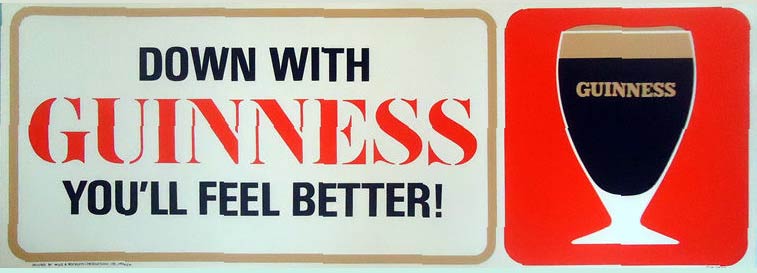 Interesting first ad, it’s quite challenging and probably difficult to sell to the client?
Interesting first ad, it’s quite challenging and probably difficult to sell to the client?
It was obviously bought by a very ballsy client.
I guess that kind of idea goes all the way through to ‘I’ve never read the Economist. Management Trainee, Age 42′.
It exuded confidence and that’s part of what advertising does for a brand, whatever one thinks of Apple, they ran a poster campaign about the camera that didn’t tell you how many pixels they use or that it has a Zeiss lens, they just say ‘Shot on an iPhone 6’.
You look at the picture and you go ‘Wow!’
It says everything.
A example of wonderful confidence, it shows they have such confidence in their product that they can state it their message very simply.
Great brand belief, it’s a good example of what advertising should be doing.
Why get into advertising?
I sort of went to art school at the age of 15, Saturday morning art school at Hornsey College of Art.

It was a wonderful way of being exposed to creative career.
After a while I realised I wasn’t going to be a fantastic painter, but I met some lovely teachers, one of whom, Peter Green, said ‘You enjoy ideas John, you should study Graphic Design’.
He told me the place to do it was the London College of Printing.
Was that where you met John Gillard?
That’s right.
When I got there I discovered everyone wanted to be artists, it was all about what was the best shade of blue, I wanted to do ideas.
I just loved starting with a blank page, most of the designers simply wanted to know what words they needed to design.
There were a number of tutors there, but John was the one who talked ideas, he was the one who said that ideas were transformative.
He’d show us the work coming out of New York at the time, the great, classic Doyle Dane work at the time, this is around 1964.
Weird, I had a similar experience whilst at college.
One day the tutor said ‘We’re going to show you the work of… a bit of an oddball, he doesn’t seem to care about typefaces and don’t get me started on his colour choices, his thing is’ she didn’t use air quotes, but she may as well have, ‘his thing is “ideas”‘.
It was Bob Gill.


I thought this work is amazing, funny, arresting, clever, far better the the overly worked, dull as ditch water bits of design we were usually shown.
Yeah, well his work spoke to you.
How did you switch from graphic design to advertising?
Advertising was frowned upon by the tutors running the graphic design course, they thought you’d sold your soul to the devil, despite the fact that they were training people to do pack design and stuff like that, so I had to work on advertising in my spare time.
One of the briefs they always gave the students was to redesign the Tax form, it was typography exercise really, so everyone would debate things like whether it should be sans serif because it was more modern or serif because it was more readable.
I decided the Tax form was just boring and people didn’t like it.
So I did a tax form with lots of cartoons; about money and finance, my logic was that you had to make it entertaining to carry people through it.
When I presented it they just didn’t know what to say, it was like ‘No, no, no, the purpose of the exercise was for you to redesign it’.
I’d explain that I had redesigned it, the reason to redesign it is to get people to use it, so I’d made it easier to use.
They didn’t want to know, my solution was just so off anything they wanted.
It was fascinating to me, it made me aware that these people were just talking to themselves.
Nobody gives a shit about whether it’s in Caslon, Garamond, Baskerville, sure, pick a nice typeface and make sure it’s easy to read, but there are a thousand of those, and it’s just a matter of opinion which one you go for, but what’s the idea?
Caslon isn’t an idea, it’s a typeface.
That for me was a wonderful example of where their thinking was wrong.
The question should what are we trying to do here? What’s the purpose? What are we trying to engage people with?
That’s what advertising did, and I loved it.
How did you get in?
Well, I was lucky.
I was going out with a very beautiful girl who was at the LCP for two days a week, the rest of the time she worked in the Daily Mirror Design Department.
One day I went around to see her at the Daily Mirror building in Holborn, while there I got talking to an American guy who did their posters, he was a writer, and we got chatting about me getting into advertising, he’d heard of Doyle Dane and PKL and that whole American scene.
Then he said ‘I’ve got about two years worth of old New Yorker Magazines, want them?’
I said ‘Not half’
I would literally go through page by page pulling out the great ads, and they were all there because anybody who was anybody put their ads in the New Yorker.
That was my education.
I’d literally paper the wall in all this great work, wonderful ads like ‘If they run out of Lowenbrau serve them Champagne’, just brilliant lines and I’s stare at them and think why is that great?
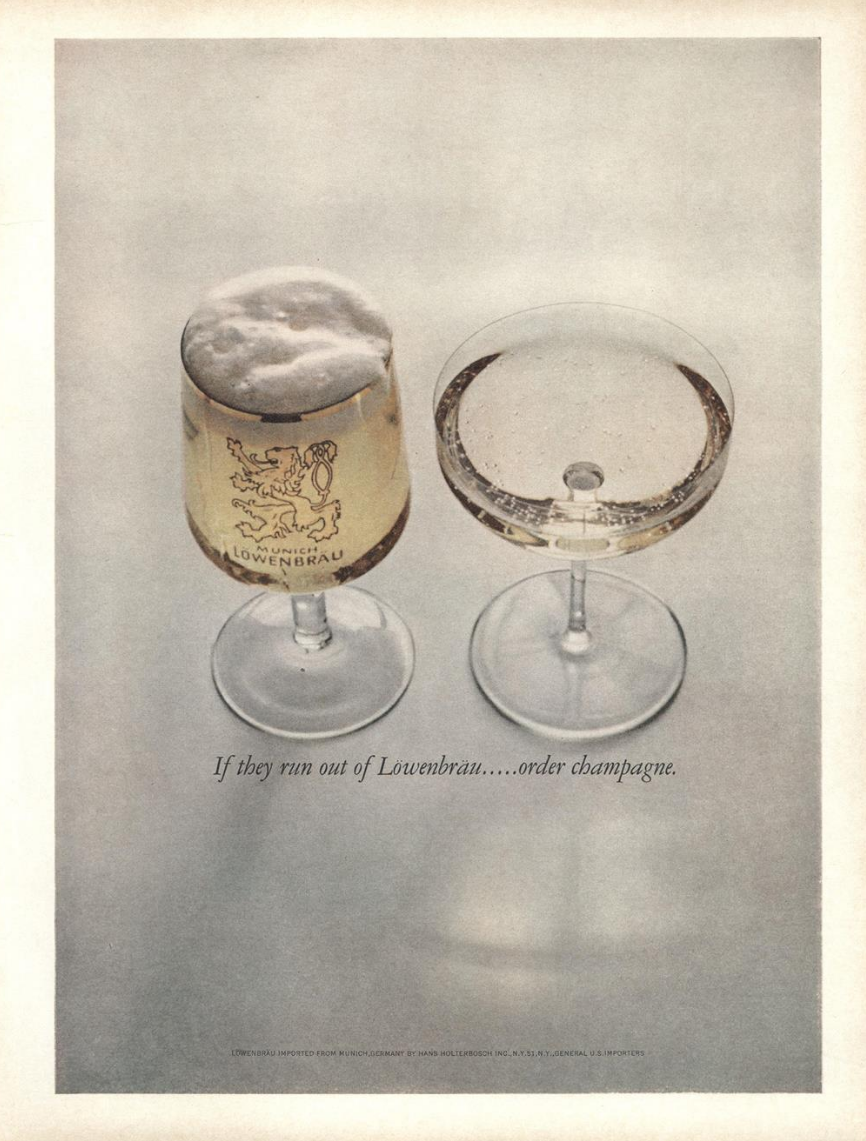
That in itself was a brilliant education.
It’s like if you were studying architecture you’d go back and look at the great work of Frank Lloyd Wright and others, and ask yourself what they were trying to achieve there?
Why do you think people don’t study advertising history like that?
We’ve always been a business obsessed with tomorrow, but it’s one of the sadnesses of our industry, creative people coming into it have no understanding of what’s gone before.
No other creative industry would operate under those circumstances.
If you studied architecture you’d absolutely know who Mies Van Der Rohe was, who Richard Rogers is, who Phillip Johnson was.
Or cinema, what makes Quentin Tarrantino, whether you like him or not, is his amazing knowledge what’s gone before him.
It’s shocking.
I can remember coming into the business and digging out all the books, The Hundred Best Ads and so on, and we’d read them from cover to cover, we were aware of what was going on and what had been going on, even though we were coming in wanting to change things for the better, we knew what had been done.
We understood where good things had been done and we’d kind of use them as a guide going forward.
So you’ve done this home course in advertising, via a hundred or so copies of the New Yorker, you then get a job at Benton & Bowles?
Yes, I got two job offers, one from Y&R for about £2,000 year, which in 1965 was a lot of money, and got an offer from Benton & Bowles for about twelve quid a week or something,
And I asked a friend who’d been ahead of me at the LCP and had since got into the industry, called Doug Maxwell, and he told me that I should take the Benton & Bowles job, as they’d just hired this very, very good art director from New York called Dan Cromer, who’d won all these gold awards at the New York Art Directors Club, and stuff like that.
He said he might change it.
So of course I get there, within two weeks of being there, the Creative head; Jack Stanley comes into my area and says ‘I’ve found a young writer for you to work with’
‘Oh ok, who’s that?’
‘His name’s Charles Saatchi.’
I thought ‘Oh no, Italian, therefore he lives at home with his mum and can’t spell. Just my luck.’
Well of course he wasn’t Italian, but he did live at home with his mum and he wasn’t very good at spelling.
At the time anyone who could vaguely string a sentence together and felt like they were pointing to the future were snapped up.
Being an art director was a definite disadvantage, you had to learn a lot about techniques and processes, all the craft aspects; if you were shooting for 65 screen, if it was four colour, today nobody gives a shit about all that, but then it took far longer to be considered an art director.
We worked together for about six or seven months, then he went off to work at Collett’s with Ross Cramer, a very good, much more senior art director. He was about 30, Charlie and I were 22 or 3.
Was he any good, this Charlie Saatchi character?
Fabulous.
He was really terrific, he had that understanding of how do we make that proposition really work?
He had a very single minded focus you need to create great work.
Very good writer.
But he had a vision of where he wanted to take the business, he was a man in a hurry, even then.
We always had a bet who was going to get to five grand a year salary first, he beat me on that.
We worked together for six or seven months, we did some very nice work, none of it ever got published though, we just weren’t taken seriously.
So that decision to go Benton & Bowles worked out, so I went there, the lesson was don’t go for the money, go for the opportunity.
But you leave?
Ultimately Benton & Bowles wasn’t a good agency.
But it was good to start there, I always felt very sorry for people who started at BBH, because they thought ‘well this is what advertising is like, people really want to buy your ideas, you’re encouraged, you’re given opportunities’.
Eventually they’ll go elsewhere and get a big shock.
I was there for about eighteen months and then got fired…
Fired? Why?
I was a pain in the arse, I kept telling them what I thought.
Back then the creative department wasn’t the most important department in the agency, it was just one of many departments, we were just considered a bunch of longhairs, people would come and brief us on what the client wanted and we’d have to argue our case.
So there was a real schism in the agency between the Creative department and the rest, Dan Cromer turned out to be a nice guy, but sadly, for me, he wasn’t strong enough to overcome that, he didn’t have the authority, he had the talent and skills, but not the authority, back then it was run by the account people.
The big debate at the time was ‘Hard Sell’ versus ‘Soft sell’, people like us were coming along saying you have to entertain people to get them to engage, which was soft sell, the hard sell view was you have to beat them over the head with repetition.
This raged until on to the mid-seventies, until Collett’s started producing all those wonderful ads like Hovis, Heineken and stuff like that.
I remember I used to have this wonderful auntie in Harpenden, she was really middle England, thought the Daily Mail was a terrific newspaper, she asked me ‘John, do you do those Hovis ads? They’re really good’.
I thought that’s it, they’ve done it, they’ve got my auntie in Harpenden.
It changed the debate on creativity, clients would go ‘wait a minute, this so-called creative stuff is really working.
Increasingly, because hard sell was based on repetition, and the cost of airtime was going up, clients couldn’t afford to run 20 spots a night.
So you had to have something different.
That’s why in my view there have only been two great advertising agencies, and that’s Doyle Dane Bernbach, because they invented modern advertising and Collett Dickenson Pearce here in London, because they took creativity to the people, they didn’t operate on the fringes, they were centre break News At Ten, Bang!
That ended the hard sell/soft sell debate, all of a sudden all these big agencies like Thompson’s suddenly thought we better start taking this creativity stuff a bit more seriously.
Today nobody uses the phrase ‘hard sell’.
So you’re fired from Benton & Bowles,
It was quite difficult, as I said before, when you’re an art director you had to do an apprenticeship, you had to be around a long time to be considered an art director, four or five years, so it was the wrong time for me to be fired, it was too early.
Anyway this offer came up, funnily enough through Ross Cramer, who said they were looking for someone to work on the the Israeli Airline El Al, so Ross said to the guy ‘You should talk to John Hegarty, he’s a terrific art director’
They called me up and I got the job.
It was a little agency on the corner of Soho Square and Greek Street, and they had two accounts; Russian precision watches, Sekonda and El Al.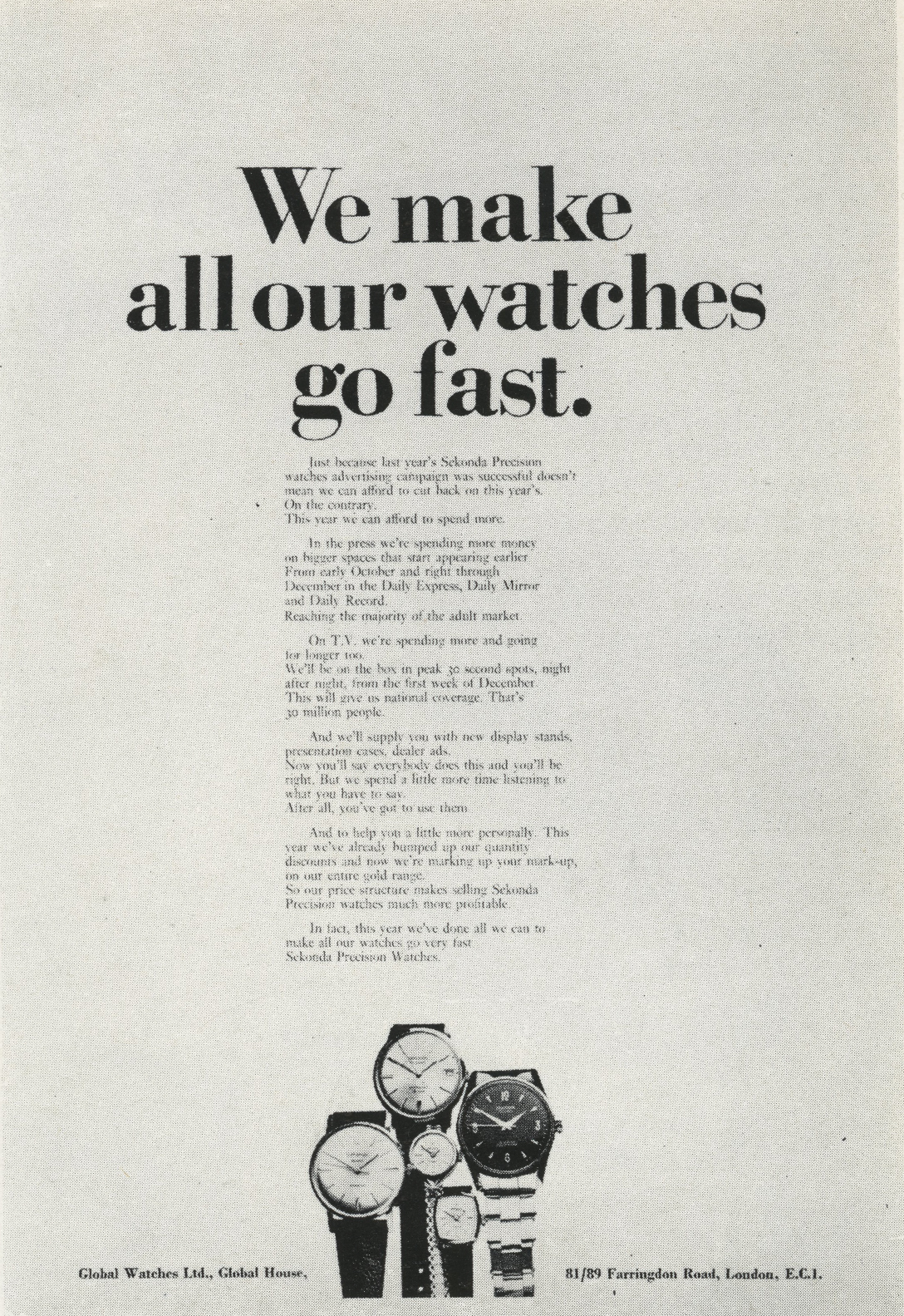

They realised the crap that they were doing didn’t work and they needed someone to do some great work on it, and so I was hired to do it, so I was able to begin to do the kind of work I wanted to create.

The first writer I worked with was a freelance guy called Dennis Hackett, who went on to be the editor of Nova, lovely guy, he wasn’t really an advertising guy, but he got it.
The very first ad we did was to run in the Jewish Chronicle, it was about El Al’s service, and Dennis wrote a headline that said ‘If you fly El Al it serves you right’.
It was almost like that ‘Down with Guinness’ thought,
and it was the first piece of work I got into D&AD.
And I realised if you do good work, daring work, you could make a difference.
That also taught me that, despite what Collett’s were doing, sometimes you attack from the edges, you do little ads, the client may think ‘Oh, that’s rather good, I quite like that’, then they let you do the bigger ads.
After a while we were running a national campaign in the Observer, the Sunday Times and places like that for flying to Israel.
They’d been running ads done by Fletcher Forbes Gill, like ‘What’s long tall and slim and is always in the sun?’ and it was next to a photograph of a girl standing on a beach.
They were ok, but they hadn’t really made an impact.
Obviously, I knew what Doyle Dane had done in the states, so I said ‘You’ve got to sell the Bible’, that’s what makes the difference, I could go to Spain and get some sun, sunshine isn’t exclusive to Israel’. So we did a campaign using the Bible, and biblical stories that was very successful.
So we did a campaign using the Bible, and biblical stories that was very successful.
we had to do ads about sunshine but we did a picture of Noah holding his hand out with the line ‘Yes, it has been known to rain in Israel’.



It was a great lesson in how you differentiate one brand from another.

How did you get this bad agency to do good work, at the age of 23?
They didn’t really know the difference.
They had a good account man there called Richard Cope, a young turk, so Richard was our ally.
What I realized was that sometimes smaller agencies have the benefit of speed, at Benton & Bowles everything took forever, it was so structured.
At a small agency you learn a lot more because you are on the front line, sometimes we didn’t have a department that did that, so you’d do it yourself.
So I learned a lot more about the business, I was also meeting clients, which was unusual at the time, account men did that, you didn’t take creatives, they might swear, but at such a small agency you are the agency, so you just did it.
I hear you wanted to bring in a new team; Charles Saatchi and Ross Cramer from Collett Dickenson Pearce?
That’s right, the agency had aspirations to embrace this exploding creative revolution, Collett’s was really starting to get momentum, Doyle Dane had opened in London, so there was a sort of vibe out there that this was going to be important, so Richard Cope had persuaded the management that for them to succeed they had to change, so there was an opportunity for John Collings.
Richard said to me we need another team, more senior than me, so I asked Ross and Charles whether they’d like to come and talk to the agency, they are trying to grow they agency?’
To cut a long story short, they joined…
Ross and Charles left the best agency in the Country to join John Collings?
Yeah.
Within about two or three months they realized this wasn’t going to work, that the management of the company didn’t want to put in the investment, they said ‘Come on, let’s all set up a creative consultancy’.
So we all left and set up Cramer Saatchi.
Initially Cramer Saatchi was working to agencies, like a freelance resource?
That was the primary source of income for us, agencies would call us up and say we have a problem with such and such an account and we need you to work on it.
Was that just the three of you?
No, at John Collings I was working with a lovely guy called Lindsey Dale, who decided he didn’t want to leave with us, so I hired a writer called Mike Coughlan.
Mike stayed for a year and a bit.
Then you hired my old boss; Chris Martin?
So there were four of us, two teams.
Then we hired Jeremy Sinclair and an art director called Bill Atherton. Then there were six.
Life was pretty simple, financially we knew we had to do a campaign every two weeks and sell it, for the agency to make money.
We were doing some direct work, like Island Records.
Did you work with Chris Blackwell? (Island Records Founder.)
I dealt with him once.
Island didn’t really want to work with a big agency, but realized they had to market their product, in all these new magazines that were starting up, like Time Out, so they came in to us for a meeting, with myself, Charlie and Ross.
They said ‘There’s one thing you have to understand guys; we don’t believe in hype’.
We all said ‘Absolutely, we don’t believe in it either, it doesn’t work here’.
Once they’d left, one of us turned to the other two and said ‘What’s hype?’, ‘I don’t know, I thought you knew’.
From then on but then on we’d deal with the producers of each album, they were like the clients.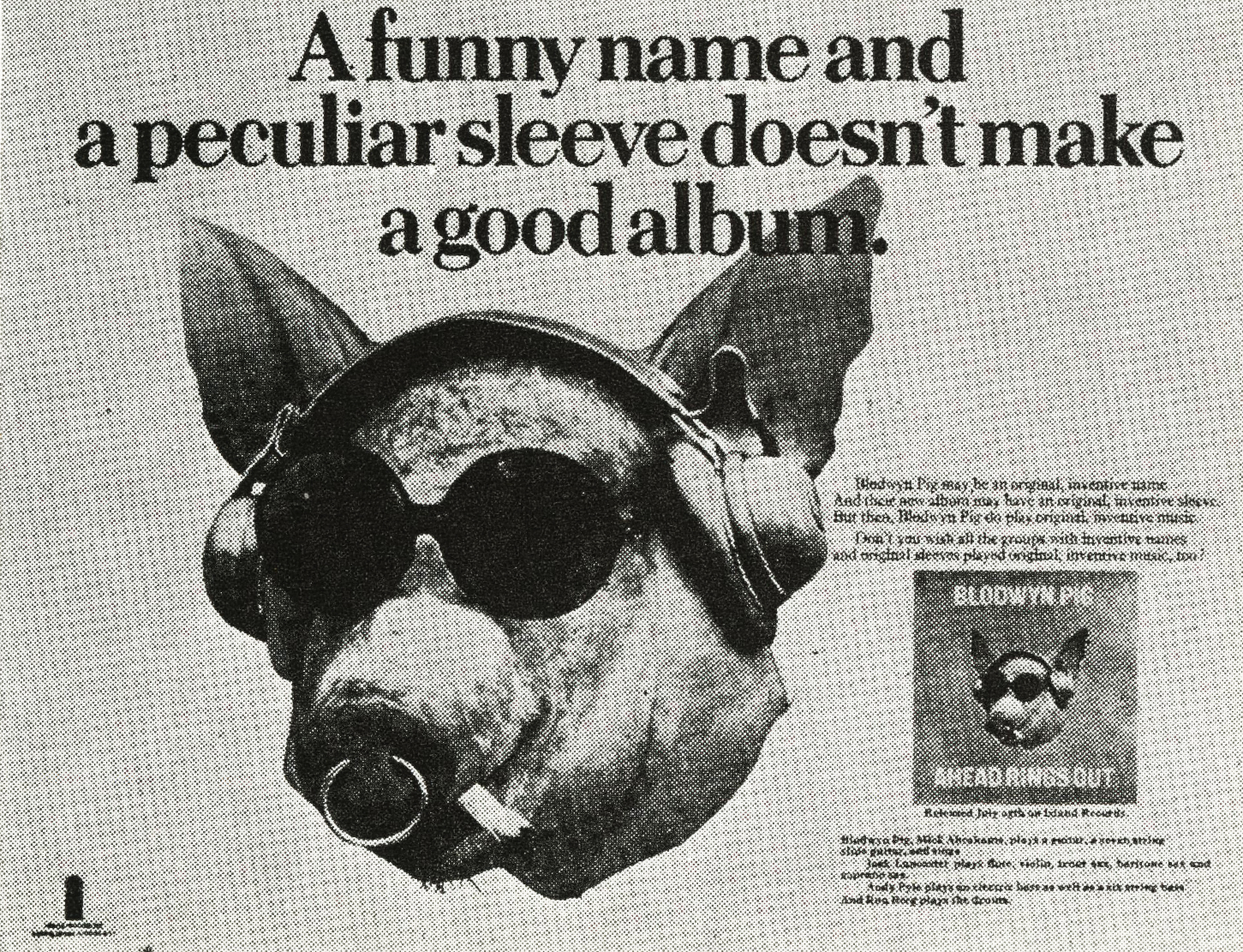

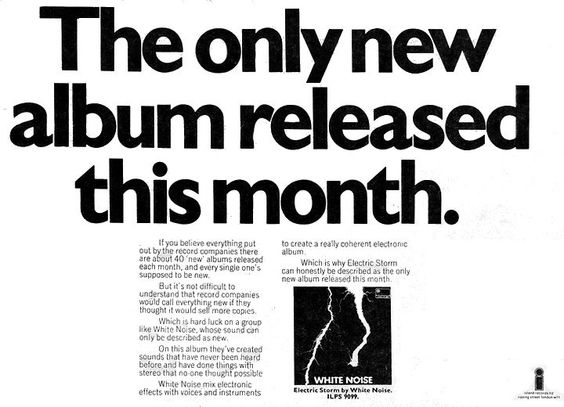
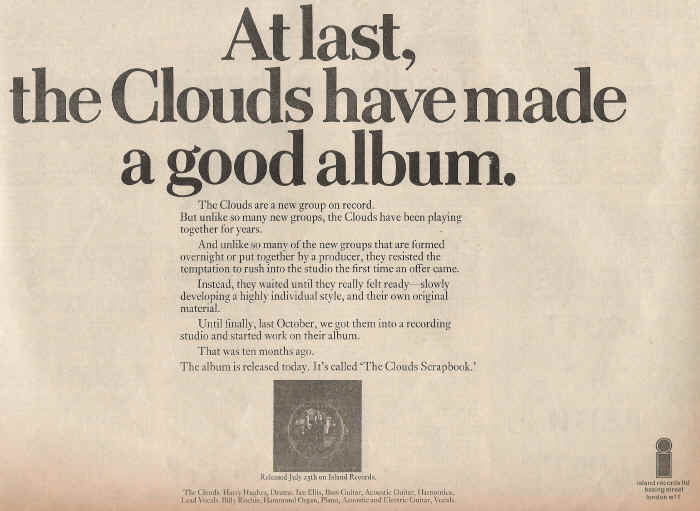
They were great to work with.
One of our ideas was instead of Island telling you what they felt about their album, to get reviewers to review the album, and we’d print whatever they said, good or bad it was.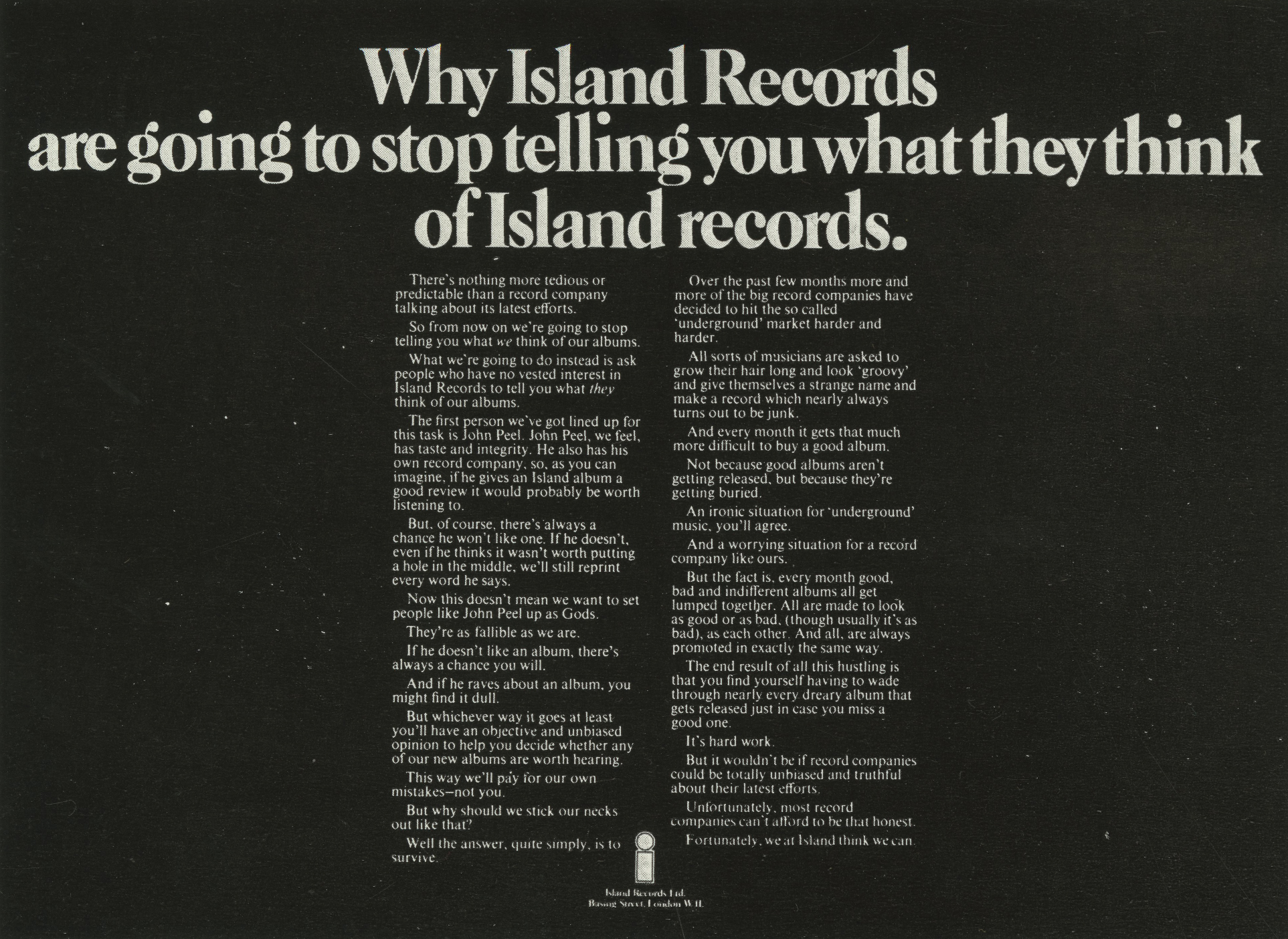 I remember a meeting with the producer Guy Stevens, a very renowned producer, he came in and said I’m starting this new band, we need to talk about how we market them, I said what are they called, ‘Mott The Hoople’ he said, ‘Trouble is they haven’t got a good singer, I’ve got two possibles, but I can’t decide who to go for…one of them is a bit odd, he won’t take his sunglasses off’.
I remember a meeting with the producer Guy Stevens, a very renowned producer, he came in and said I’m starting this new band, we need to talk about how we market them, I said what are they called, ‘Mott The Hoople’ he said, ‘Trouble is they haven’t got a good singer, I’ve got two possibles, but I can’t decide who to go for…one of them is a bit odd, he won’t take his sunglasses off’.
‘Sounds interesting, why don’t you go with him?’ I said.
That was Mick Hunter.
What was life as a consultancy like?
Great, it was a real hothouse.
But eventually Charlie realised that if you didn’t own the relationship with the client you were just the hired help.
Charlie decided he wanted to have an agency, Ross decided he didn’t, he wanted to direct.
Charlie asked if I’d go with him and become a partner at the agency, he told me he was going to bring his brother with him, who was working for Haymarket magazines, in charge of business development.
I asked Charlie why Maurice; ‘He’s even younger than us, is it viable?’
He said ‘I can trust him’ and I got that.
So in 1970 Cramer Saatchi became Saatchi & Saatchi.
What was the first client, H.E.A?
It’s always been a bone of contention, because at Cramer Saatchi that was the other client, and we did some wonderful work for, the ‘Pregnant Man’ was one of them, so Charlie took it to Saatchi & Saatchi, but that account was bought in by Ross, and I think he always felt there should’ve been a bit more of an admission that he was part of this.
But that early work, the anti smoking, etc, always gets mis-credited to Saatchi & Saatchi, whereas it was Cramer Saatchi.
So your ad ‘This is what happens when a fly lands on your food’ is possibly the first ad I can remember seeing, at my doctors, my ‘Down with Guinness’, maybe because it was so unusually disgusting?

What was great about that was that whole centre section came straight out of a pamphlet, taken wholesale, it was a very technical description, we just top and tailed it.
It’s a great example of doing your research, reading up on your subject.
I always loved that ad, because in David Ogilvy’s second book he uses that ad as an example of what you shouldn’t do; reverse out white type out of black.
A lawyer friend of mine at the time said you realise you could sue him for a lot of money for that, it’s defamation of character, and the reason you can sue is that it’s not written from an independent point of view, he was writing on behalf of Ogilvy & Mather.
I thought no, I can’t be arsed, I was rather pleased to be honest that I’d done something that David Ogilvy disapproved of.
The other H.E.C ad that doesn’t get a mention, but got a D&AD gold, the car crash ad, Is that a real road crash?
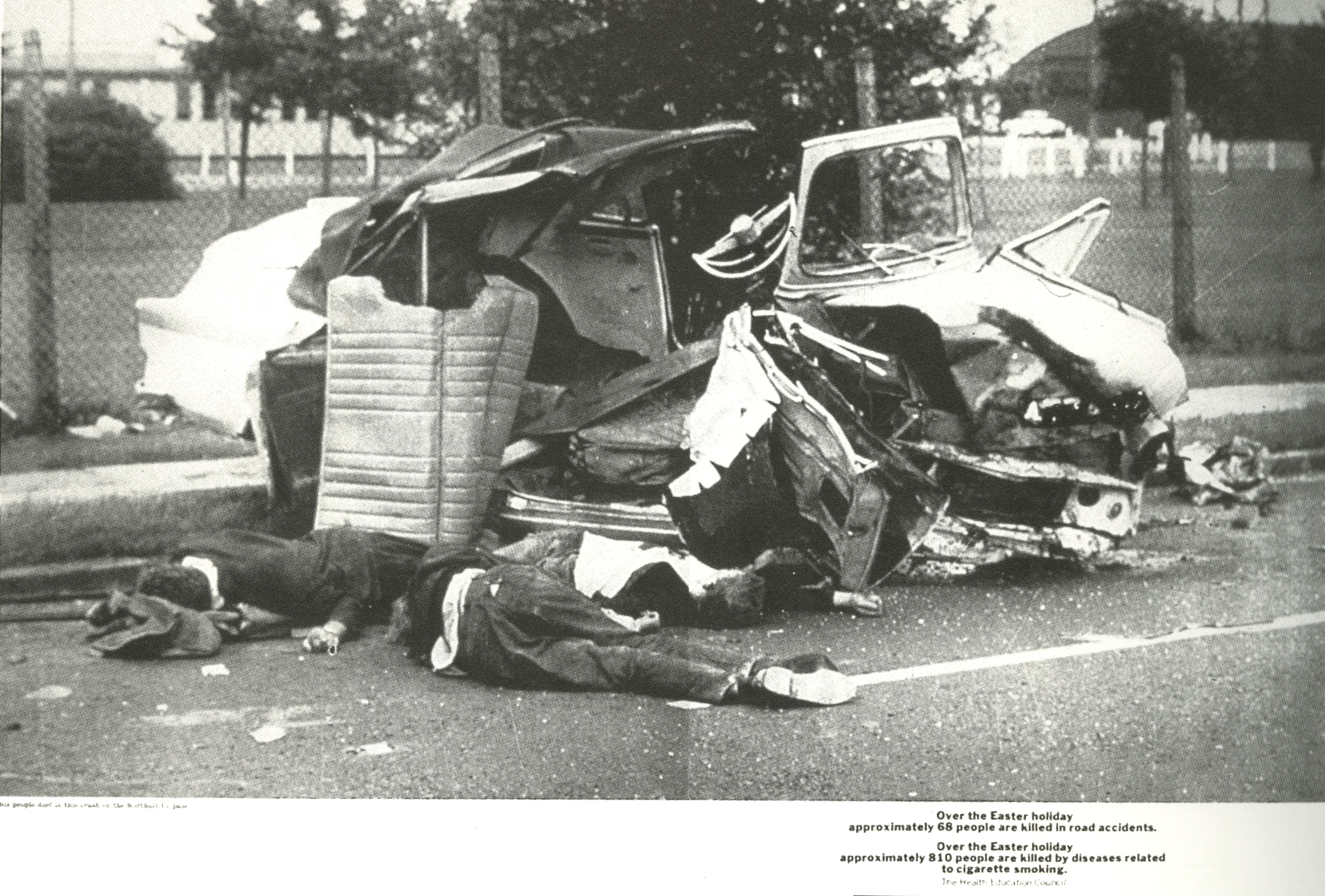
Yes, we got the picture straight from the evening Standard.In those days they would publish the road death figures after every national holiday, so we ran than just after the Easter holidays to get people to understand just how many people were dying from smoking.
Charlie said I don’t want to run ads that say ‘smoking kills’, because people think yeah, but it’ll never happen to me, or they’ll have a relative who’s 92 and smoked every day of their lives, I want to run ads that say this will happen to you,, every single cigarette you smoke is doing this to you.
That was the real skill of that campaign, that thinking lead Charlie and Ross to write ads like ‘You can’t scrub your lungs clean’ and ‘No wonder Smokers cough’.
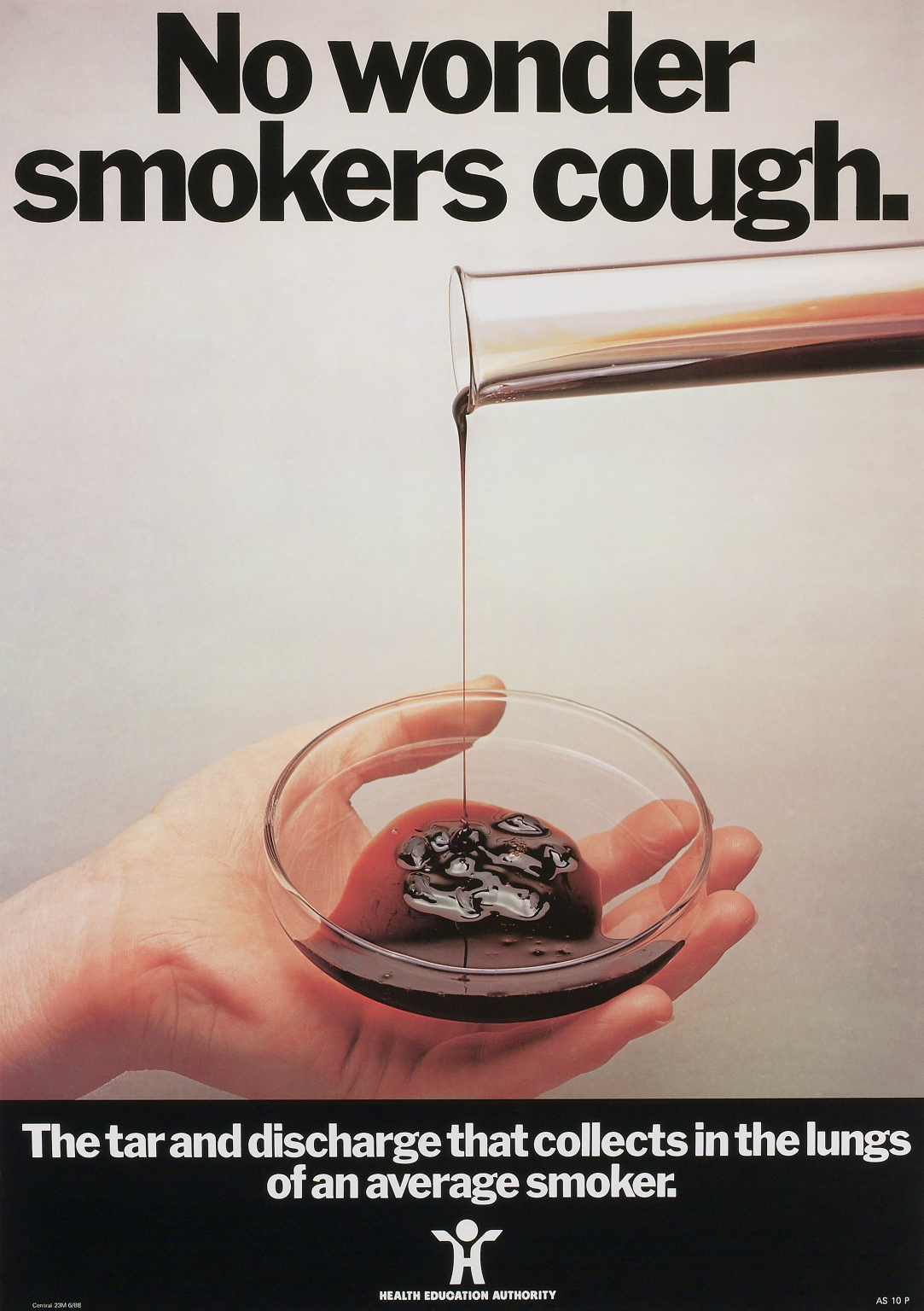
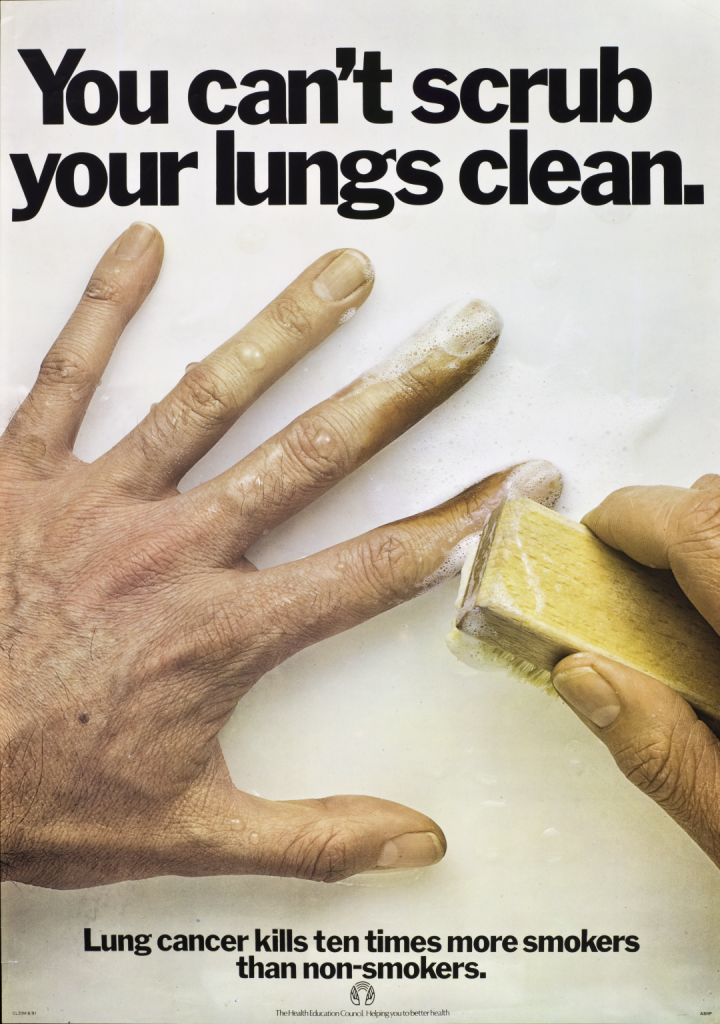
Also, remember at that point we couldn’t say ‘Smoking gives you cancer’, there wasn’t sufficient proof at that time, the cigarette companies would come after you.
I remember once giving a speech in Germany in the late eighties, and I made some comment about the illogicality of peoples choices, that they are emotional not logical.
I used the example of cigarettes and said ‘Why would anyone smoke? It kills you, it even says so on the pack’.
I came off stage and some guy came up to me and said ‘could I have a word? I’m from Phillip Morris and I just want you to know I could sue you for what you just said.’
I told him to ‘fuck off, sue me’.
But that’s how vicious those people can be.
 The whole campaign was unusually forceful for the time?
The whole campaign was unusually forceful for the time?
Yes, I guess we were just applying the principles of brand advertising to cause advertising, people hadn’t really approached it in a professional way before.
There was a lovely lady who Ross got to know who Flora something, she got it, she thought yes the Government should be more effective, it should be professional, not continue in this amateurish way.
And it was very ground-breaking work.
But then the sad thing with Saatchi’s, the cynical thing, was when they ditched that and went and worked with Silk Cut.
Shame really lads.




 So you became Deputy Creative Director?
So you became Deputy Creative Director?
Yes, Charlie was always very nonchalant about titles, but yes he gave me that title, but I was a partner, a shareholder, which was more relevant to me than titles.
But in the end, Charlie ran it, there were no board meetings or anything like that.
Obviously, as an agency not into hype, in 1972 a story is printed in the Sunday Times saying the creative Department has been insured for £1m? That was Charlie, a brilliant publicist.
That was Charlie, a brilliant publicist.
We didn’t have any news at the time and creativity was starting to be more and more coveted, so Charlie and thought how do we get people to believe we had the most creative creative department?
He got an old mate to write up a policy and we had a story.
Brilliant!
 Why leave?
Why leave?
Charles was starting to make decisions I wasn’t comfortable with, very close to the edge legally, taking on business where there was no opportunity to do good creative work, but he didn’t seem to mind, growth was the new obsession.
Then the TBWA thing came up.
I think Dawson Yeoman had turned it down, a lovely writer from DDB.
I was about third or fourth.
Again, I got recommended by Ross Cramer…and Alan Parker.
Did you know Bartle and Bogle, or were you thrown together?
No. Martin Denny had been hired by TBWA as their guy in London, as Chairman, and he put us all together.
It shouldn’t have worked really, but some how we worked it through.
John was the biggest hero really, he was at Cadbury’s in the Midlands, doing very well, he was very well thought of, he would definitely have ended up running Cadbury’s.
What business did you have when you opened?
None.
We were above the Saxone shoe shop off Hanover Square.
It was very tough in the beginning, trying to sell the idea of a European network to marketing directors who were more interested in what was happening in Chelmsford.
What changed?
Well, we got Ovaltine, then J&J, then Lego.
Well I guess with the Ovaltinees, the plan was always to tap into that pre-war nostalgia.
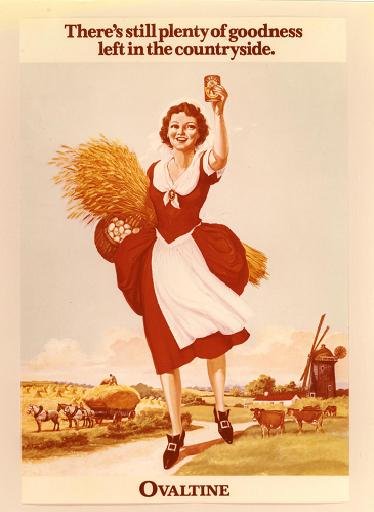

You did good creative work on each, did that help?
Not at first, often the first work you do on an account isn’t great, it could be because you don’t have time or you continue old thinking.
With Lego for example we began by doing trade ads, to the toy industry.
We decided that we shouldn’t necessarily do the traditional trade ads type ads; ‘Make money with Lego’, we thought let’s do proper ads, consumer type ads that push the benefit of Lego.
So we did ads like the ‘From little acorns grow big oak trees’.
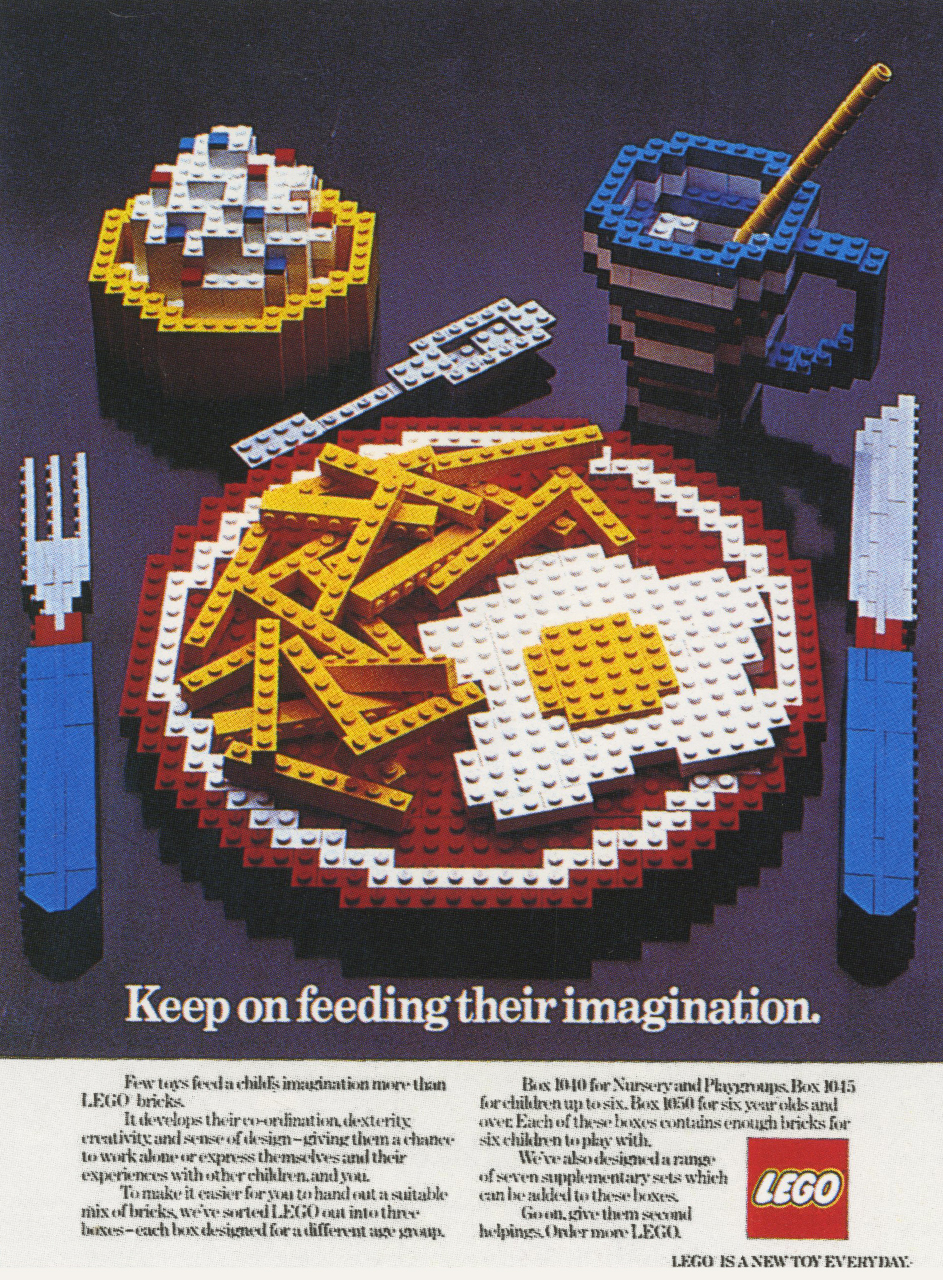
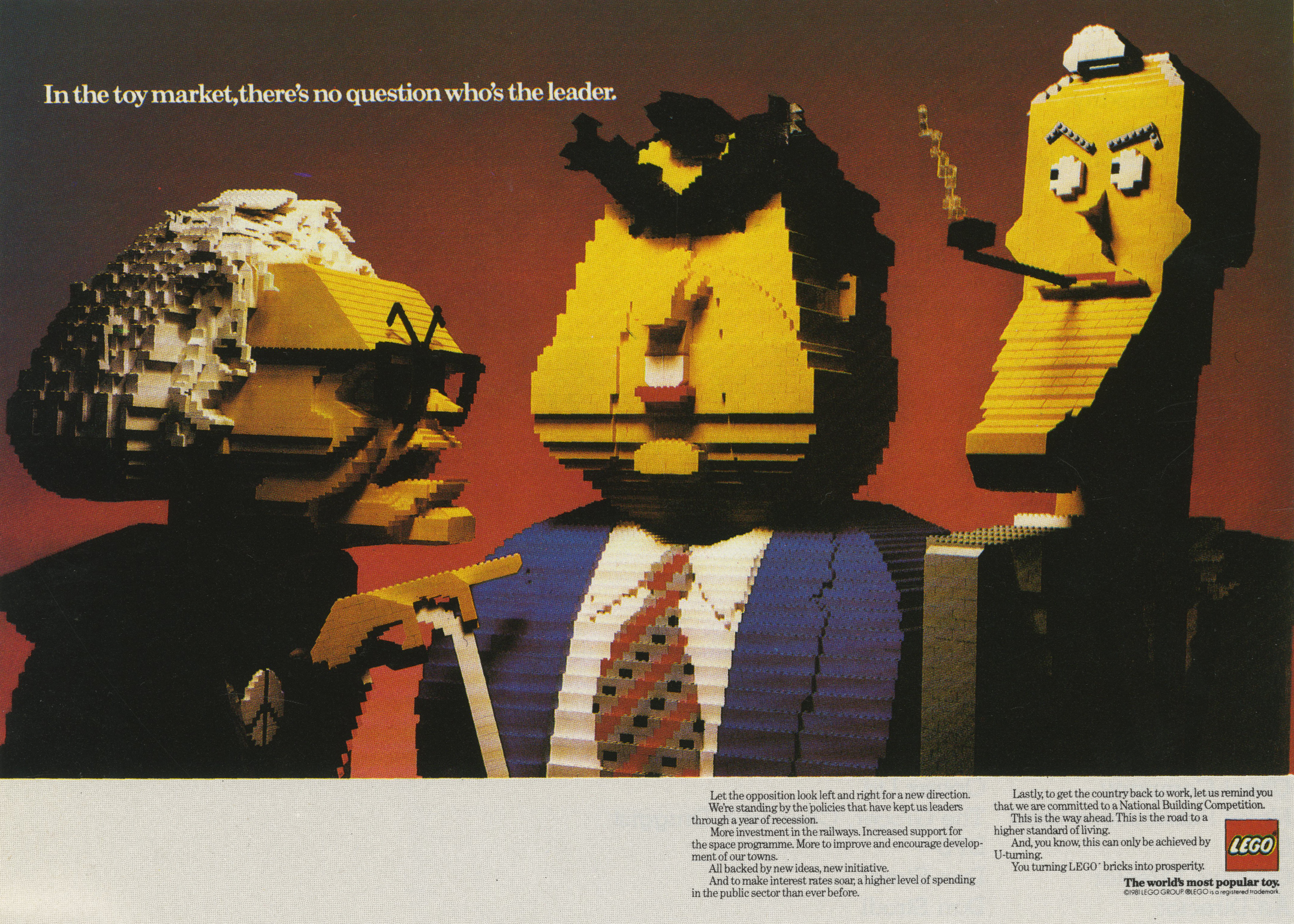 They were very well regarded, they’d win awards at D&AD and Campaign Press, and get noticed, nobody ever said they were just trade ads, they’d say they were good ads.
They were very well regarded, they’d win awards at D&AD and Campaign Press, and get noticed, nobody ever said they were just trade ads, they’d say they were good ads.
They set the the tone of the consumer ads as the business grew.
But it wasn’t easy, the clients at Lego fought the against the playfulness of this kind of advertising, they wanted a more functional ‘Use it and learn’ type approach.
The way we ended up persuading the clients to go with us was to record and show them an episode of the kids show ‘Tiswas’.
They were horrified!
It was chaos, people running on and off screen, pie-ing each other, but it made our point.
You could draw a straight line from those early trade ads to the ‘Kipper’ ad, which won the Grand Prix at Cannes many years later.
Johnson Jnr?
Well the challenge was that we were given research that said every time they ran an ad with a baby in every woman engaged, the problem was that they couldn’t remember who it was for.
So we had to figure out a way of making our ads branded, which is why we came up with Johnson Jnr, with the marvelous Richard Briars doing the voiceover.
Of course there were a whole bunch of concerns about a talking baby, a man voicing a baby, etc, but it just worked.
You did some great stuff on Newsweek, I particularly love the ‘History of the World’ ad.
They were a terrific client.
Always coming to us saying we have space we need to fill in their magazine, it lead to the Guy Gladwell ad.
One of the few things I was speechless about when the painting was presented to me, in a gallery in Chiltern Street.
I bought the painting for £500.














How did you hire creatives?
I didn’t want superstars.
I didn’t want to deal with their egos and tantrums, I wanted to find people who I thought showed talent and give them a shot.
It was also partly due to circumstance, we didn’t have the kind of money Collett’s had.


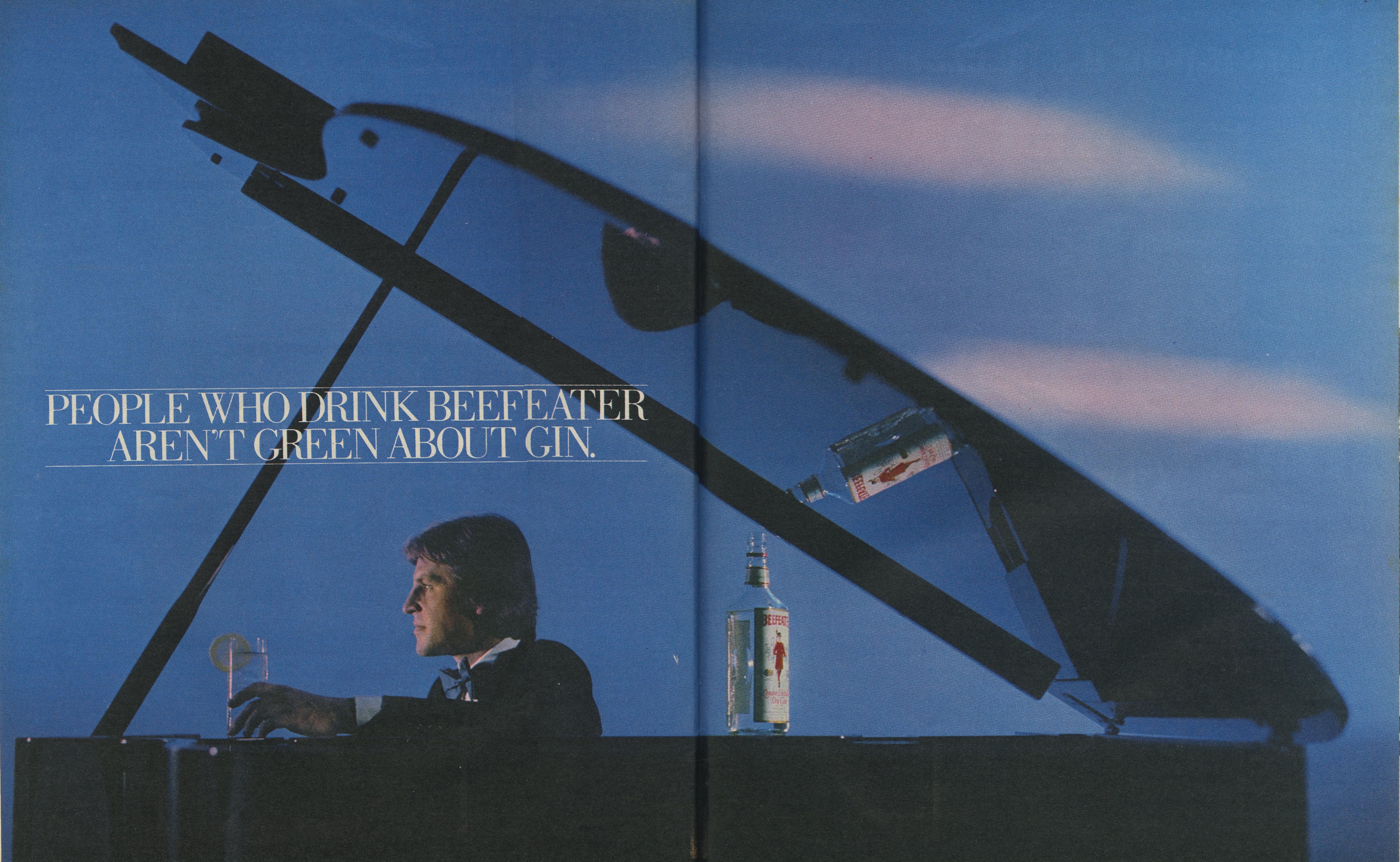

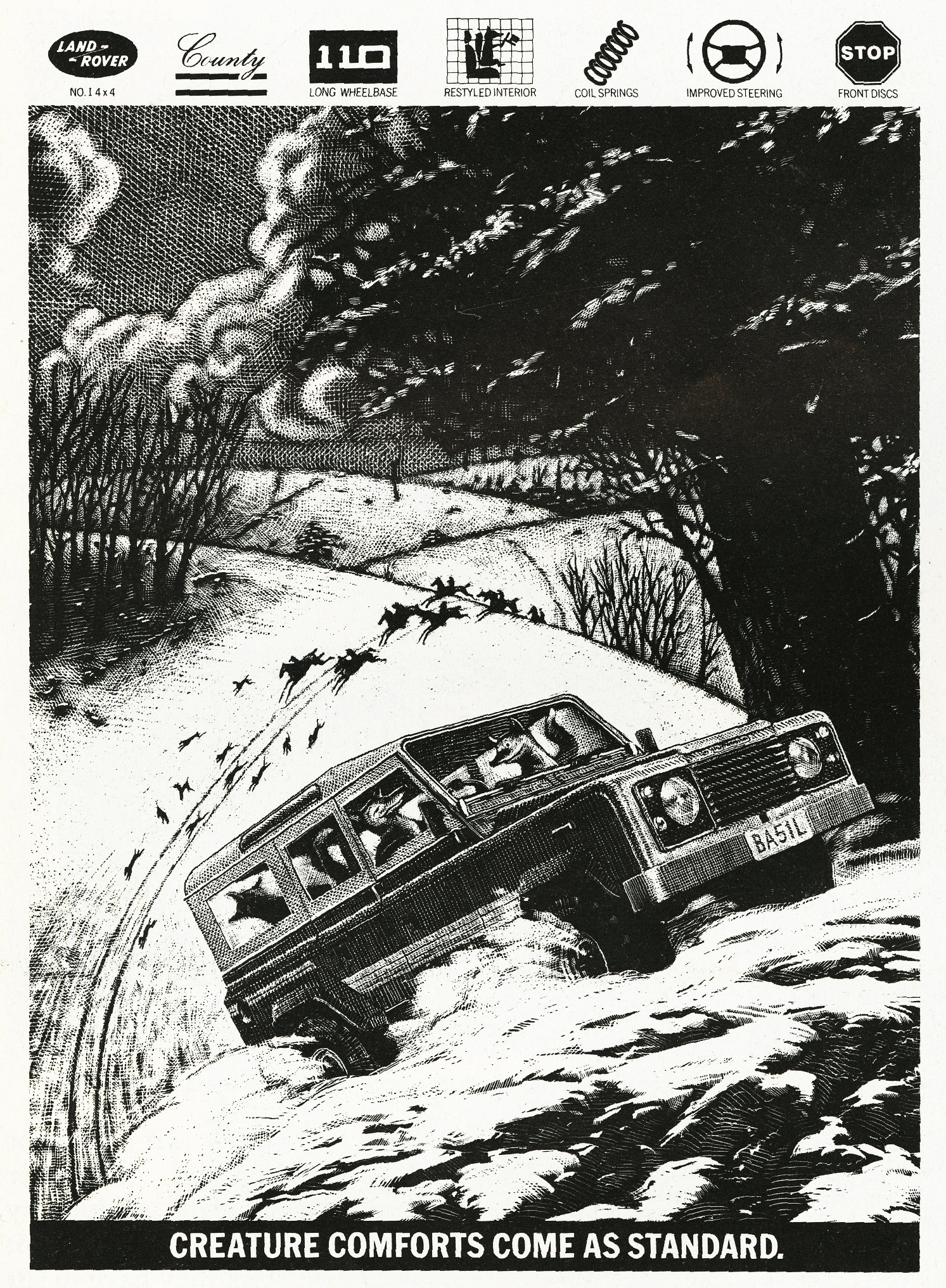

Why leave?
We were getting frustrated with the way TBWA was run.
Globally.
They sold in this idea of giving the partners 10% of the agency in a particular country, but 1% of the global network, we were told that the 1% was worth the big money.
It sounded good.
But we found that agencies would set up in Greece or Spain that would do terribly, but the partners in that country thought ‘we’’, it’s not ideal, but not to worry, it’s the global 1% that’s worth the money’.
So there was no incentive to make their country work.
We were doing great in the U.K. at that point, and tried to argue for a change in structure.
They declined.
A few years later they did change it to what we’d suggested, but of course it was too late.

Great practice?
Absolutely, we always used to say our company was in incubation at TBWA for the first 8 years.
Thank you, Dave (and John). An encouraging piece to read of a cold November afternoon. Great work, brave clients. BBH and JH in particular have been a perpetual beacon for which we are all in their debt.
Now if I only had a decent, tough brief to keep my hands warm.
Great as always, Dave! Sounds like Advertising 101! I loved every bit of it.
Another great piece Dave. I don’t know here you find the time but please keep up the evening/weekend job. Ben
This is really interesting, I know nothing about advertising but I love the style of your posts!
Thanks Alex, what business are you in? D.
Hi Dave, just saw this – I’m a second year history student at Queen Mary University of London
Meeting and knowing John changed my life and led to a career in advertising. A knighthood well earned.
Really do like your blog Dave, but am a bit bemused as to why this one has the Land Rover foxes ad I created with Alex Ayuli in summer of 1984.
That was made a while after BB and H had left TBWA.
Illustrator was Jeff Fisher, and that is a scraper board (does anyone still make pics with that now?).
Bemused Nick?
What do you think I’m up to?
It’s obviously a mistake, I’ll take it out.
Dx